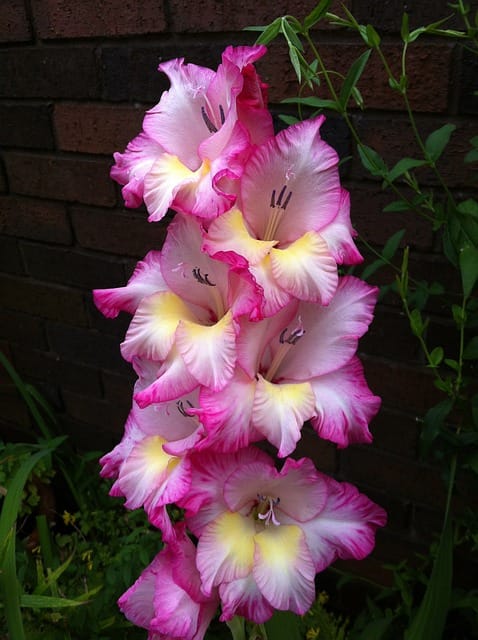How to grow Gladioli
Gladioli flowers, also known as sword lilies, are elegant and vibrant additions to any garden

In this article:
- Introduction
- Selecting the Right Variety
- Choosing a Suitable Location
- Soil Preparation
- Planting Gladioli Corms
- Watering and Hydration
- Fertilizing for Healthy Growth
- Providing Adequate Sunlight
- Supporting and Staking Gladioli
- Pruning and Deadheading
- Managing Pests and Diseases
- Harvesting Gladioli Blossoms
- Storing Corms for Future Planting
- Dividing and Propagating Gladioli
- Troubleshooting Common Issues
- Conclusion
Introduction
Gladioli flowers, also known as sword lilies, are elegant and vibrant additions to any garden. With their tall spikes and beautiful blooms, they are a favorite among flower enthusiasts. Whether you're a beginner or an experienced gardener, this article will guide you through the process of growing gladioli.
Selecting the Right Variety
When selecting gladioli corms, consider the desired height, color, and bloom time. There are numerous varieties available, ranging from dwarf gladioli suitable for containers to taller types for garden borders. Choose a variety that suits your preferences and the conditions in your garden.
Choosing a Suitable Location
Gladioli thrive in sunny locations that receive at least six hours of direct sunlight each day. Ensure that the area has well-drained soil to prevent waterlogging and root rot. Additionally, select a spot protected from strong winds to avoid damage to the tall flower spikes.
Soil Preparation
Prepare the soil by loosening it to a depth of 10-12 inches. Remove any weeds or debris and incorporate organic matter such as compost or well-rotted manure. This improves soil fertility and drainage, creating a favorable environment for gladioli to grow.
Planting Gladioli Corms
Plant gladioli corms (or bulbs) in spring after the danger of frost has passed. Dig holes that are 4-6 inches deep and spaced 6-8 inches apart. Place the corms with the pointed end upward and cover them gently with soil. Water thoroughly after planting to settle the soil and initiate growth.
Watering and Hydration
Gladioli require consistent moisture during their growth period. Water them regularly, keeping the soil evenly moist but not waterlogged. Avoid overhead watering, as it can promote fungal diseases. Mulching around the base of the plants helps retain moisture and suppress weed growth.
Fertilizing for Healthy Growth
To promote healthy growth and abundant blooms, fertilize gladioli every 2-3 weeks with a balanced liquid fertilizer. Alternatively, you can apply a slow-release granular fertilizer at the beginning of the growing season. Follow the manufacturer's instructions for the application rate.
Providing Adequate Sunlight
Gladioli need sufficient sunlight to produce strong stems and vibrant flowers. Ensure they receive at least six hours of direct sunlight daily. If your garden lacks full sun, consider planting gladioli in containers that can be moved to sunnier spots when needed.
Supporting and Staking Gladioli
As gladioli grow, their tall flower spikes may require support to prevent them from bending or breaking. Install stakes or plant supports near the corms at the time of planting. As the stems grow, gently tie them to the supports using garden twine, ensuring they remain upright and stable.
Pruning and Deadheading
Remove spent blooms regularly to encourage continuous blossom production. Pinch or cut off faded flowers just above the first bud or leaf node. Additionally, once all the flowers on a stalk have faded, you can cut the entire stalk back to the base, promoting a neat appearance and focusing the plant's energy on new growth.
Managing Pests and Diseases
Gladioli can be susceptible to common garden pests such as aphids, slugs, and thrips. Regularly inspect the plants and take appropriate measures to control pests, such as using insecticidal soap or organic pest control methods. Watch out for diseases like botrytis and fusarium wilt, and promptly remove and dispose of infected plants to prevent the spread.
Harvesting Gladioli Blossoms
Harvest gladioli blooms when the flowers are fully open and the bottom one or two flowers on the spike have started to open as well. Cut the stem at a 45-degree angle just above the first or second leaf node. Place the cut stems immediately in lukewarm water to enhance vase life and enjoy their beauty indoors.
Storing Corms for Future Planting
In colder climates, gladioli corms need to be lifted and stored for the winter. After the first frost blackens the foliage, gently dig up the corms, being careful not to damage them. Remove excess soil and allow the corms to dry in a cool, well-ventilated area for a few weeks. Store them in a mesh bag or paper bag in a cool, dry place until spring planting.
Dividing and Propagating Gladioli
Over time, gladioli corms multiply and may become crowded. To maintain vigor and prevent overcrowding, divide the corms every few years. Dig up the clumps, carefully separate the individual corms, and discard any damaged or diseased ones. Replant the healthy corms, following the same planting instructions as for new corms.
Troubleshooting Common Issues
Gladioli can face challenges such as yellowing leaves, stunted growth, or lack of blooms. These issues may be caused by overwatering, nutrient deficiencies, or environmental factors. Evaluate the conditions and adjust watering, fertilizing, or sun exposure accordingly. If problems persist, consult a local gardening expert for further assistance.
Conclusion
Growing gladioli can be a rewarding experience that adds vibrant colors to your garden or floral arrangements. By selecting the right variety, providing suitable growing conditions, and following proper care practices, you can enjoy the beauty of gladioli flowers throughout the growing season. Happy gardening!
